|
Forest & Shade Tree –
Insect & Disease Conditions for Maine
August 23, 2021
In This Issue:
Abby Karter has been hired as a new Entomology Technician based out of Windsor. A native of Winslow, Abby is keenly interested in the natural world and has showed great enthusiasm in learning about her new position and the diverse roles to fill. She has already begun providing excellent assistance to the staff entomologists and pathologist with various tasks and project work including beech leaf disease survey, insect trapping, sorting trap catch and much more. We warmly welcome Abby to the Forest Health Monitoring team!
Amy Emery, a highly skilled and valued Forest Health and Monitoring Conservation Aide for the last six years, has transitioned to a new position. Luckily, she did not leave the Maine Forest Service (MFS) or have too far to move, as Amy was selected as the new Office Associate at the Augusta Insect and Disease Lab. In addition to her technical skills, troubleshooting and knack for providing excellent assistance, Amy brings to the position an already deep knowledge of our division and understanding of our wide-ranging activities. One of Amy’s first initiatives in this position has been rolling out and curating the ‘This Month in History’ segment in the Condition Reports. Amy will be the new friendly voice on the phone when you reach out to the MFS Insect and Disease Lab. We are excited to continue to work with Amy in her new role with the Forest Health Monitoring team!
The Board of Pesticides Control (BPC) has provided two updates related to the pesticide bills heard during the last session of the Maine Legislature The first provides details and links to additional information on bills that will become law on October 18, 2021. The second provides details about three resolves. You can learn more at the BPC website www.thinkfirstspraylast.org and by attending the board's public meetings.
Browntail Moth (Euproctis chrysorrhoea)
August marks the beginning of the new generation of browntail moth (BTM) caterpillars. We have now seen egg mass hatch across our monitoring sites throughout the infested areas in Maine. We began seeing the first egg masses hatch during the week of August 1. As of late last week caterpillars were starting to create the web in which they will spend the winter. The webs of our native fall webworm (FWW) are also present across much of Maine. In late summer, distinguishing between the two can be difficult, especially if webs are out of reach. FWW webs will often, but not always, be larger this time of year. They will also lack the bright white silk coating the twig that the BTM caterpillars lay down as they travel back and forth. However, the easiest way to distinguish between the two this time of year is the size of the caterpillars. Caterpillars of BTM will generally not exceed one quarter inch in length until next year. Those of FWW are variable in size at this point, but most are already longer than a quarter inch. If webs are out of reach, waiting for more distinguishable differences between the two structures in fall may be the only feasible way to determine identity of the resident.
Treatment of the very young caterpillars in late summer can be difficult for a few reasons:
- The damage from the younger caterpillars can be difficult to detect, as they don’t consume the entire leaf but graze on the outer surface of the leaf creating a damage called skeletonization.
- Caterpillars are not necessarily found on the same trees that were defoliated previously in the season, although in areas with high populations this is possible. This means there is a possibility of treating trees that have no BTM caterpillars in them, which is not optimal from an environmental or financial standpoint.
- Caterpillars produce silk and feed under it, limiting their exposure to pesticides.
Stay tuned for continued weekly developmental updates on the Maine Forest Service page and for some major revisions to the frequently asked questions page.
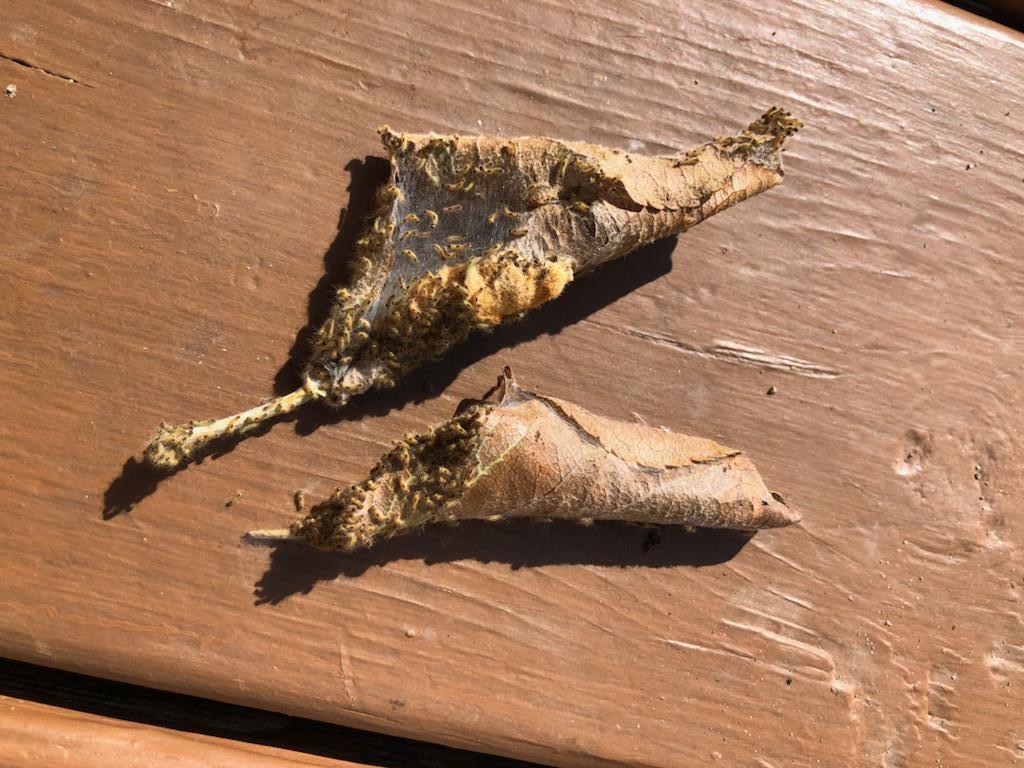 Image: Beginnings of a BTM winter web. Kathy Murray.
Elm Cockscomb Gall (Colopha ulmicola)
Galls caused by the elm cockscomb aphid were noted during surveys for zigzag elm sawfly. As with most leaf galls, the elm cockscomb gall is eye catching, but not of significant concern to tree health. When mature, the galls resemble the comb seen on chickens, the reason for their common name. Life stages of this aphid alternate between elm leaves and grass roots. Joe Boggs at Ohio State University Cooperative extension has an informative blog post featuring this aphid.
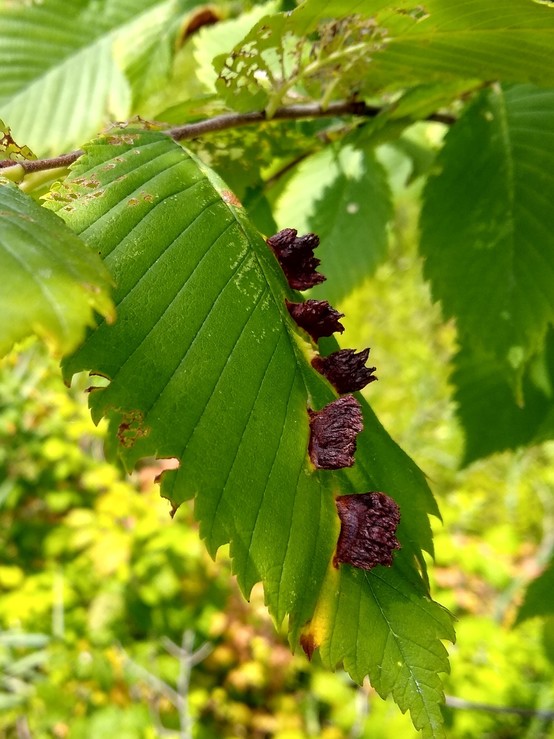 Image: Elm cockscomb gall.
Red Pine Scale (Matsucoccus matsumurae)
Red pine scale was confirmed in Steuben, Washington County. This is an invasive bast scale of hard pines including red pine (other hard pines native to Maine are not impacted by this species). This is the first confirmed report of red pine scale in Washington County. It has also been confirmed in Hancock and York County. The scale is likely more widespread since infestations often go un-noticed until the trees are in severe decline. Areas infested by red pine scale may see 100 percent mortality of the red pine within them. Confirmation of prior infestation can be difficult in areas where trees have already died, since the evidence degrades after the scales have died. Winter harvests of infested trees can help to limit both spread of red pine scale and long-lasting impacts from Heterobasidion root disease at the site. Material harvested outside of winter, especially branches and upper stem sections, should be kept on site if possible until they have dried out.
White Pine Weevil (Pissodes strobi)
The native white pine weevil kills the top of some species of conifers and is the most serious economic insect pest of white pine in the northeast. Preferred hosts include eastern white pine and various spruces such as Norway, white and Colorado blue spruces; occasionally attacking other pines.
One of the first symptoms of attack in the spring is the presence of pitch flowing from the feeding punctures in the previous year's leading shoot. Beginning in late June the new growth on infested shoots starts to droop. Shortly thereafter the tops die and turn brown and up to 2–3 years of top growth may be destroyed. The damage results in trees that are multi-topped, crooked, and of much lower value for saw-timber. Field staff have reported seeing obvious signs of white pine weevil damage that is apparent this time of year due to the browning tops. We have also fielded several calls from homeowners regarding the damage caused by this species. Plantations, open-grown trees, and ornamentals are most heavily affected due to the vigorous growth of the leader which the white pine weevil prefers to attack.
This time of year, management of damage is limited to corrective pruning of the damaged tops. To prevent infestation next year, management must take place in very early spring. Physical barriers should be in place before snow melt, and chemical controls are applied as the adults emerge from thawing soil. Several factsheets detailing the biology and management of white pine weevil can be found on the Got Pests? Website.
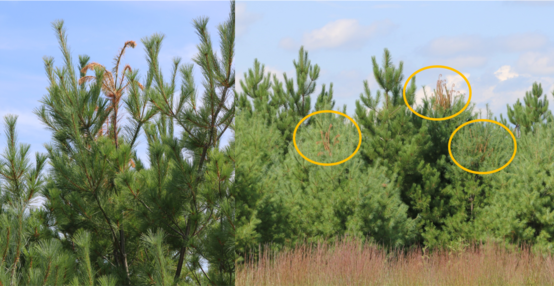 Image: Damage typical of a white pine weevil infestation.
Hemlock Woolly Adelgid (Adelges tsugae)
All spring and summer (since late March), we have been reminding people about how easy it is to start a new hemlock woolly adelgid (HWA) infestation by moving infested hemlock foliage, or even just by brushing against infested branches and picking up a tiny, almost-invisible crawler. These female crawlers are able to produce up to 300 eggs each without mating, meaning that moving just one to a new tree can start a new infestation.
There are two generations of HWA per year, resulting in overlapping generations of HWA eggs and crawlers being generally present on the branches from March until August. However, the last of the crawlers are now settled onto the new growth where they will be for the remainder of their lives. Therefore, by the beginning of September it will be safe to work in infested hemlocks without the danger of spreading HWA to new trees. Similarly, if your trees are not yet infested, you can work in your trees without the fear of bringing in crawlers on equipment or vehicles or even clothing.
The tiny black nymphs settled at the base of the needles may be visible with a hand lens or magnifying glass. Once attached to the twig, they go into aestivation (the summer equivalent of hibernation). In October, HWA will leave aestivation and will begin to feed. As they feed and grow throughout the fall and winter they produce waxy material from pores on their bodies making them more visible. By late-October or November the waxy ‘wool’ covering live adelgids can be seen on the undersides of the most recent growth of infested hemlock twigs. Sometime in late-winter they will begin to lay eggs and will again be readily spread from infested trees. If you are interested in learning more, see our web page on the complex life cycle of HWA.
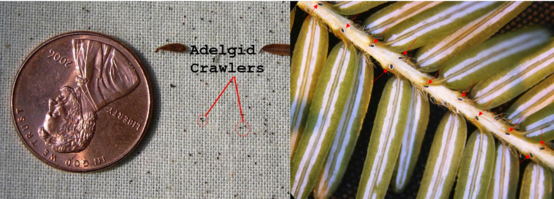 Images: (left) Mobile hemlock woolly adelgid crawlers; (right) Hemlock woolly adelgid nymphs settled on twig.
Emerald Ash Borer (Agrilus planipennis)
This summer, we have continued to monitor for emerald ash borer (EAB) as it expands its range in Maine. Because there is no one ideal method for surveying for EAB, we are using several methods.
Purple prism sticky traps: These are set and serviced primarily by the Maine Forest Service with some help from cooperators and are hung outside the area regulated for EAB.
Green funnel traps: These are placed both outside the regulated area, as well as inside the quarantine zone, in areas where EAB is not yet found. They are operated primarily by volunteer citizen scientists who collect samples from them every two weeks. EAB was found earlier this summer via this method in the new town of Buxton by a volunteer.
Visual survey/landowner reports: Maine Forest Service personnel conduct surveys for EAB, with the most common symptoms seen being woodpecker feeding and crown decline. Reports from landowners continue to be important as we track the spread of EAB.
Biosurveillance: The native non-stinging wasp, Cerceris fumipennis, hunts our native buprestids (related to EAB) to feed its young. When EAB is present, this wasp is also very good at hunting them. We monitor colonies of C. fumipennis (often found in baseball diamonds!) to see what prey the females bring back and whether any EAB have been captured. Last summer, EAB was found by C. fumipennis in a colony in Kittery.
Girdled trap trees: This spring, Maine Forest Service, along with many volunteers and cooperators, girdled ash trees in areas where EAB has not yet been found. By removing the bark around the circumference of the trunk, the tree is stressed in a particular way which makes it more attractive to EAB. In the fall, we will peel these trees and look for signs of larvae under the bark. Girdled trap trees are one of our most sensitive and effective methods of monitoring for EAB. If you are interested in monitoring for EAB on your property, we will be looking for more volunteers next spring. For additional information on this program, see our website on EAB trap trees.
Image: Cerceris fumipennis carrying a native buprestid. M. Bohne, USDA Forest Service.
Beech Leaf Disease
Following its initial detection in late May 2021, beech leaf disease (BLD) has been found throughout the Midcoast area of Maine. We have been pleased to receive many landowner reports of leaf disorders of beech from around the state, and while some have been confirmed as BLD, thankfully many reports have been BLD look-alike disorders which can be seen in the previous month’s conditions report.
A recent survey of the Midcoast area conducted by MFS staff found BLD-infected trees within the area from Belfast west to Montville, south to Appleton, continuing south to the Warren area and east to Rockland. Islesboro was also found to be generally infested with BLD (see image). There was an additional report of BLD on Mt. Tuck in Stockton Springs, although this area has not been thoroughly surveyed, but will be in the coming weeks. In other BLD news, the first of eight long-term monitoring plots will be established to track the development and impacts of BLD over the next five years. This will be a cooperative effort initially funded by a grant from the US Forest Service. Plots will be established in areas already impacted by BLD as well as in areas where no BLD symptoms are present. This will help to answer questions about the future of beech tree health in Maine.
If you see beech leaves that look like those pictured above, or if you have questions about BLD, contact aaron.bergdahl@maine.gov or call (207) 287-3008.
 Images: (top left) Dark interveinal bands of a BLD-infected leaf as seen from the understory; (bottom left) BLD-characteristic leathery leaves with raised interveinal sections and non-smooth texture, unlike a healthy beech leaf; (right) the current area of Maine presumed to be infested with BLD.
Drought
Following record rainfall in July, there are still areas of Maine where Abnormally Dry, Moderate Drought and Severe Drought conditions persist, according to the U.S. Drought Monitor report from August 17, 2021. This has created an interesting mix of trees stressors. On one hand, we have trees that were harmed by the prolonged lack of water due to the very dry months of May and June to start off the growing season. The prolonged periods of wet weather in July, on the other hand, have favored the increase of some tree disorders like the bacterial canker, fire blight, bacterial leaf spots and fungal leaf diseases leading to early defoliation. While premature defoliation is concerning, the later this occurs in the growing season, the less impactful this is to overall tree health, since the leaves have already done a large amount of photosynthesis for the year.
 Image: Map of drought areas in Maine, US Drought Monitor.
Dutch Elm Disease (Ophiostoma ulmi / Ophiostoma novo-ulmi)
Dutch elm disease (DED) is an elm bark beetle-vectored (spread) fungal disease of elm trees that continues to impact especially American elm trees wherever they grow in Maine. Despite popular belief, there are still many elm trees growing in Maine, and this allows DED to persist and continue to spread and kill elm trees. Unfortunately, there are very few fully mature American elm trees remaining on the landscape that exhibit the classic and well-loved forms and functions of this iconic tree species.
DED symptoms typically begin to develop in late-June, peak in July and new infections can even be seen into August (see picture below from Littleton, ME taken last week by MFS forester, Dan Jacobs). Symptoms of DED include early defoliation and wilting and yellowing/drying of leaves in infected portions of the crown. Upon pulling back the bark of infected twigs, brown streaking can be seen in the inner bark.
Unfortunately, therapeutic treatments for already infected elms are very seldom successful unless the disease is caught early and is aggressively pruned out of the tree. Even then, since DED is a disease of the tree’s vascular system, the fungus can move through the tree rapidly, ahead of pruning cuts, leading to a rapid decline in tree health and with tree death typically occurring within two or three years. If trees are infected via root grafts (underground root connections) to a neighboring DED-infected tree, death can occur much quicker. In situations where there are other high-value elm trees in the area, it is prudent to cut down infected trees and remove all tree material from the site. If wood is left on site, it should be tightly tarped to prevent the emergence of beetles from the diseased wood that can transfer the DED fungus to healthy trees. The best way to protect high-value elms is to inject them with anti-fungal compounds that prevent infections. This type of treatment requires specialized equipment and must be done by a trained licensed pesticide applicator.
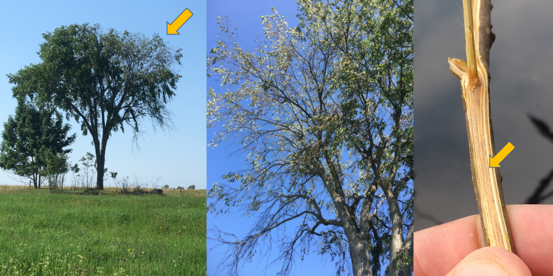 Images: (left) An American elm tree showing a section of crown with DED symptoms; (middle) A close-up of the symptomatic portion of the crown. Images by Dan Jacobs MFS; (right) Brown-stained inner bark of a DED-infected twig.
From the August 29, 1985 Condition Report:
“Ant Flights (several species): Sudden and often spectacular flights of ants have been reported over the past few days from Kennebec County. This phenomenon is quite common through mid-September and flights may include millions of individuals. Carpenter ants, cornfield ants, and several of the lawn dwelling species seem to be most often reported. Flights usually occur toward evening as the sun begins to drop. What starts out to be clear air suddenly fills with millions of fluttering ants. Their pearly wings may catch the sun and sparkle like tiny jewels. Within minutes to an hour or so the flight has left and things have returned to normal. Some of these flights perish over water and a ridge of dead ants may wash ashore.”
Details of upcoming events our staff are involved in not listed below can be found by visiting the events page.
August 30, DACF Emerald Ash Borer Update for Cities and Towns, 10:30am – 12:00pm. The Maine Department of Agriculture, Conservation and Forestry is hosting a quarterly conference call to update city and town tree and forest managers as well as public works staff on the known status of emerald ash borer in Maine, current state efforts, municipal opportunities as well as occasional updates on other insects and diseases affecting forests and trees. There will be plenty of time for Q&A.
Agenda
- Brief introduction to Update Format, Teams, Speakers (Allison Kanoti)
- Asian Longhorned Beetle Awareness (Allison Kanoti)
- Emerald Ash Borer updates
- Purple Trap Survey update (Mike Parisio)
- Trap tree and biocontrol update (Colleen Teerling)
- Quarantine update (Gary Fish)
- Emerald ash borer flight season, BMP’s and the Quarantine (Mike Parisio)
- Municipal planning grant update (Jan Santerre)
-
Lymantria dispar (gypsy moth) 2021 review, 2022 expectations (Mike Parisio)
Join on your computer or mobile app
Join the meeting
Or call in (audio only)
Mobile One Tap: +1 207-209-4724,,99559960#
Phone: (207) 209-4724, United States, Portland
Phone Conference ID: 995 599 60#
September 24, Common Ground Fair, Forest Health Talks 1:00 pm. Talks given by Mike Parisio and Aaron Bergdahl at the Forestry Pavilion.
November 3–4, Virtual – Save the Date. White Pine Weevil, Management and Tree Improvement. The Atlantic Tree Improvement Council (AtlanTIC) in conjunction with the Canadian Woodlands Forum and the Canadian Wood Fibre Centre will be hosting a virtual workshop on white pine weevil management and tree improvement. The white pine weevil is a major pest of white pine, Sitka spruce, white spruce, jack pine, Norway spruce and other species in Canada. This event will bring together white pine weevil experts, tree improvement specialists, forest managers and others to share knowledge associated with white pine weevil management in our forests and for the purpose of accelerating the implementation of plans to develop trees resistant to weevils. More information will be available soon.
Conditions Report No. 5, 2021
On-line
Department of Agriculture Conservation & Forestry
Maine Forest Service – Forest Health and Monitoring
Contributors: Aaron Bergdahl, Amy Emery, Allison Kanoti, Colleen Teerling, and Thomas Schmeelk
Unless otherwise noted, images by Maine Forest Service, Forest Health and Monitoring, DACF
|